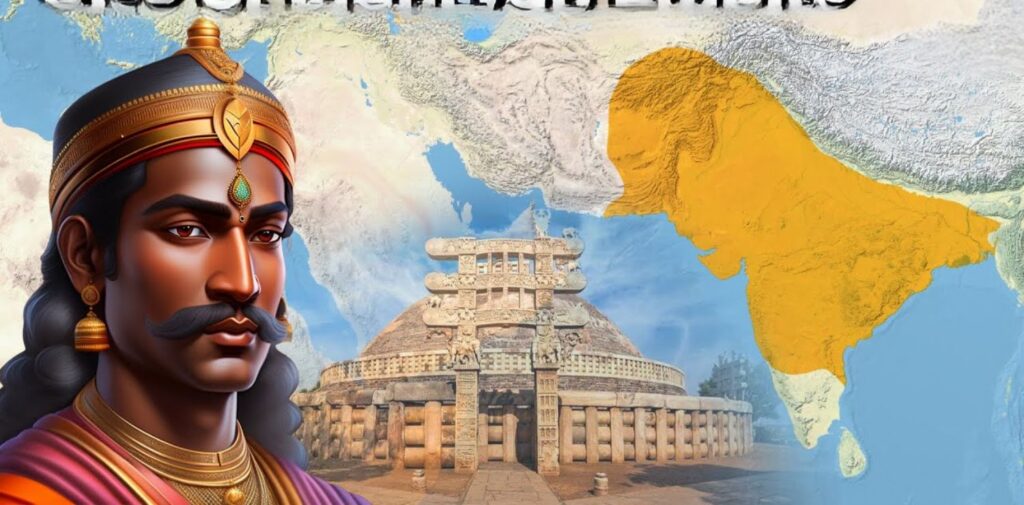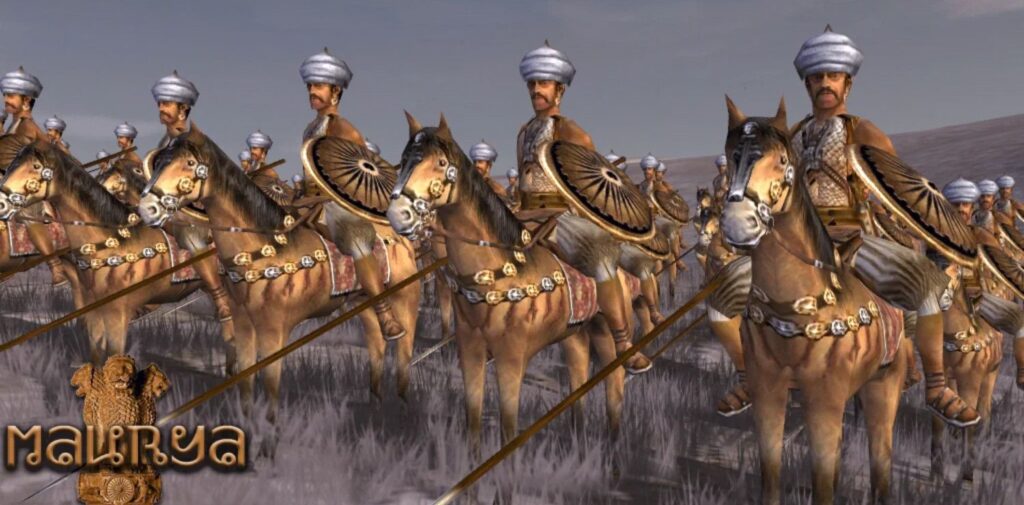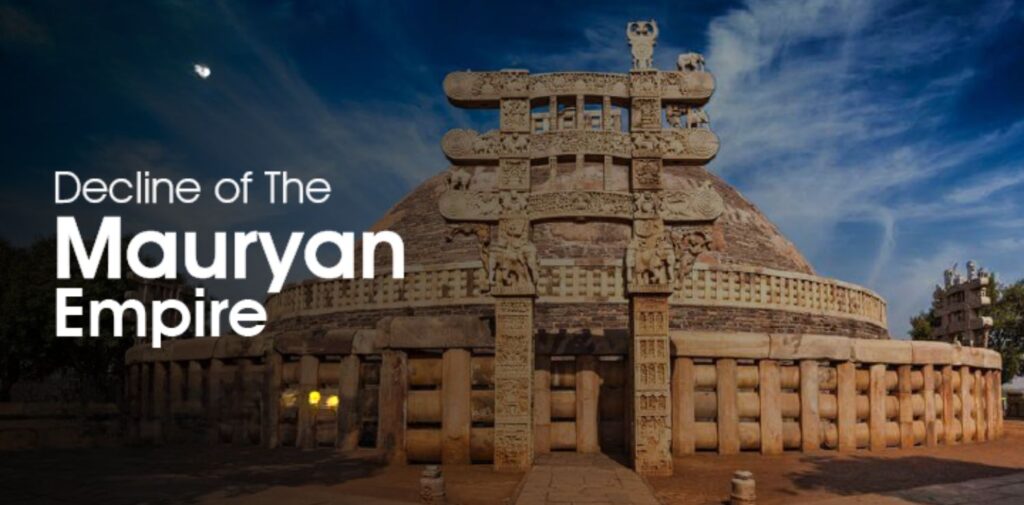The Mauryan Empire was one of the greatest empires in ancient India. It lasted from around 322 BCE to 185 BCE and covered almost the entire Indian subcontinent. It was founded by Chandragupta Maurya, who became the first emperor of the empire. The Mauryan Empire reached its peak under the rule of Ashoka the Great, one of India’s most famous rulers. However, just like many great empires in history, the Mauryan Empire eventually declined. In this article, we will learn about how and why the Mauryan Empire fell apart, and what consequences it had for ancient India.
Rise of the Mauryan Empire
Before we talk about the decline of the Mauryan Empire, let’s first understand how it rose to power. The Mauryan Empire began with Chandragupta Maurya, who was inspired by the teachings of his mentor Chanakya. With the help of Chanakya, Chandragupta overthrew the Nanda Dynasty and established the Mauryan Empire in 322 BCE.
Chandragupta’s empire stretched from the northwestern parts of India to the Deccan Plateau in the south, including the rich regions of present-day Afghanistan and Pakistan. The empire was a powerful force, and it was ruled with the help of a well-organized government and a strong army. Chandragupta’s grandson, Ashoka, later became emperor and led the empire to its greatest height. Ashoka’s rule is remembered for its commitment to peace, non-violence, and Buddhism, which he adopted after the bloody Kalinga War.

The Decline Begins
The Mauryan Empire’s decline did not happen overnight. It was a gradual process, influenced by many factors. Let’s explore the key reasons behind the fall of this once-powerful empire.
Weak Successors
After the reign of Ashoka, the Mauryan Empire faced challenges with leadership. Ashoka had no strong successor, and his children were not as capable as he was. As a result, the empire began to weaken. Successors after Ashoka did not have the same strength and vision to maintain the empire’s unity and power.
The decline of the Mauryan Empire can be traced back to a lack of strong leadership. With weak rulers, the empire began to suffer from internal divisions and struggles for power. The lack of capable rulers led to instability in the empire, making it more vulnerable to outside attacks and internal rebellions.
Economic Problems
The Mauryan Empire, like any large empire, required a lot of money to maintain its army, administration, and infrastructure. During Ashoka’s rule, the empire had a strong economy, with trade routes connecting it to other parts of Asia, the Middle East, and Europe. However, after Ashoka’s death, the economy began to suffer.
The empire faced economic problems due to heavy taxation, which burdened the people. The rich became richer, while the poor struggled. There were also fewer resources for public works, such as roads, which weakened the empire’s economic strength. The empire had to spend large amounts on the military to maintain control over its vast territories. These economic problems drained the empire’s resources and contributed to its decline.
Internal Rebellions
As the Mauryan Empire grew, it became difficult to govern such a large and diverse land. The empire was made up of various regions, each with its own culture, language, and traditions. This diversity sometimes led to dissatisfaction among the people.
Over time, people in different parts of the empire began to demand more freedom and independence. Many regions, especially in the west and south, started to rebel against the central authority. One of the most significant rebellions occurred in the region of Taxila, where local rulers wanted to assert their power. These internal rebellions further weakened the empire and made it harder to maintain control over the entire territory.

Attacks from Outside
Another major reason for the fall of the Mauryan Empire was the invasion of foreign forces. The empire’s borders were not always secure, and after Ashoka’s death, the empire became vulnerable to attacks.
In the northwest, the Greeks, who had once been defeated by the Mauryas, started to regain their power. The Kushans and other Central Asian nomadic tribes also began to invade the empire’s northern regions. These invasions stretched the empire’s military forces thin, and the Mauryan Empire found it difficult to protect its borders.
The Role of Buddhism
Ashoka’s adoption of Buddhism was a significant factor in his rule, and it brought a sense of peace and unity to the empire. However, after Ashoka’s death, the influence of Buddhism started to fade. The rulers who followed Ashoka were not as dedicated to Buddhism, and they did not give it the same importance. This caused a shift in the empire’s focus. The decline in Buddhist influence led to the weakening of the moral and ethical principles that Ashoka had promoted.
Without the unifying force of Ashoka’s policies, the empire lacked a central guiding philosophy that could hold it together.
Division of the Empire
As the Mauryan Empire weakened, different regions began to break away. After the death of Ashoka, the empire slowly split into smaller kingdoms. Some of the regions that were once part of the Mauryan Empire became independent states.
The final blow to the empire came in 185 BCE when the last Mauryan emperor, Brihadratha, was assassinated by his commander-in-chief, Pushyamitra Shunga. Pushyamitra then established the Shunga Dynasty, marking the end of the Mauryan Empire.

The Consequences of the Decline
The fall of the Mauryan Empire had several important consequences for India:
- Rise of New Kingdoms: With the decline of the Mauryan Empire, new kingdoms began to emerge. These included the Shunga Dynasty in the north, the Satavahanas in the Deccan, and the Kushans in the northwest. These smaller kingdoms were often more localized and didn’t have the same strength as the Mauryas, but they helped shape India’s future.
- Loss of Unity: The Mauryan Empire had brought a sense of unity and centralization to India, but after its decline, India once again became divided into smaller kingdoms. This division led to regional differences in politics, culture, and religion.
- Cultural Growth: Despite the decline of the empire, India continued to thrive culturally. The fall of the Mauryas did not stop the development of art, architecture, and literature. In fact, during the time of the smaller kingdoms, India saw the growth of new cultural ideas, including the spread of Buddhism and Jainism to different parts of Asia.
Conclusion
The Mauryan Empire was one of the most powerful and influential empires in Indian history. Under the leadership of Chandragupta Maurya and Ashoka, the empire grew to include vast territories and was a beacon of prosperity and culture. However, after Ashoka’s death, the empire faced many challenges. Weak leadership, economic problems, internal rebellions, and attacks from foreign forces contributed to the decline of the empire. The final collapse came when Brihadratha, the last Mauryan ruler, was assassinated, and the empire was replaced by the Shunga Dynasty.
Although the Mauryan Empire fell, it left behind a legacy that continues to shape India’s history and culture. The lessons from the decline of the Mauryan Empire remind us of the importance of strong leadership, a balanced economy, and the need to protect unity in times of change.




